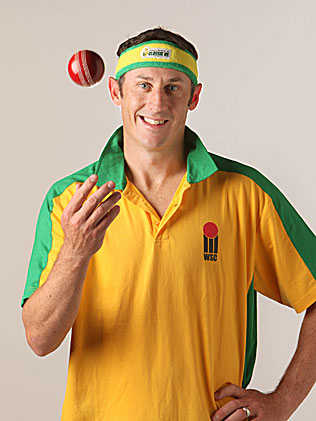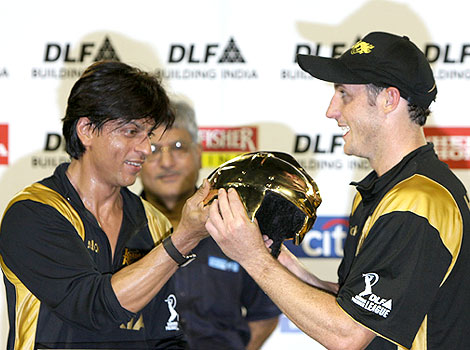David Hussey – Australia’s old yet young gem
David John Hussey was born on July 15, 1977 in the area of Mount Lawley in Perth in Western Australia just as his elder brother Michael Hussey. He has been similar to his sibling in several ways. One being that he has had to score a heap of runs in domestic cricket before winning the trust of the Australian selectors and he made his ODI and T20 debuts at the age of 30. And the other being that he has scored a massive amount runs in English county cricket, having turned up for the Nottinghamshire County Cricket Club since 2004 and has played for them till present, having being contracted with them whenever he is not playing international cricket for Australia.

He made his first-class debut at the age of 26, after he decided that his cricketing residence will not be the WACA in Perth but the Melbourne Cricket Ground in Melbourne. He took a while to rise in the ranks of grade cricket in Australia until he finally was qualified enough to make his debut for the Victoria Bushrangers in 2003-04 season. His first major innings was an unbeaten 212 against 38-time Sheffield Shield champions New South Wales in Newcastle which helped his team successfully pull off a record chase of 455 in the fourth innings. In the entire first class season, which also involved ODIs and T20s, he ended with 857 runs at an average of 61 but could still not win a place in the Australian team due to a power packed batting line-up.
The following season, his Test match form dipped dramatically, so much so that he was dropped from the ODIs to be played as well, which is called the Pura Cup in Australian domestic cricket. But that season made him grow as a player and go back to square one to hone his skills as a batsman in all formats of the game. He decided to participate in the English domestic county championship with Nottinghamshire and has remained in the team ever since due to his prolific run every season. He scored 1208 runs in his debut season in 2004 and bettered that tally with 1219 runs the next season, which gave him a lot of confidence and the hope that the Australian selectors would be keeping an eye on his performances, irrespective of which country is he scoring runs in.
Come the 2005-06, his form in the Test matches was average but he dominated the ODIs for Victoria, as he hit 535 runs at an average of 76.42 which won him the award for being Victoria’s best ODI player of the year. His ascend was then rapid as he not only continued to be one of the most consistent batsmen of the team, but also was a captaincy choice in the absence of senior and star players such as Cameron White and Brad Hodge in the 2006-07 season. It was under his leadership that Victoria became one of the few teams to get the better of New South Wales yet again in a four day contest.
But he was finally recognized by the national selection panel after he ended with more than 1000 runs in the 2007-08 season, and as a result made his debut in Australian colours in the one off T20 international against India that summer. This coincided with a Cricket Australia or a central contract, which assured him that he was to be a part of the Australian team in the near future if he continues to perform consistently.

With the national ODI side in the period of transition, the inaugural season of the Indian Premier League (IPL) took place simultaneously. This was his chance to make a big impression as the event was all set to be global. Surprisingly, David Hussey was bought in the auction at a price much greater than that of his elder brother Michael and the then Australian captain Ricky Ponting. Alongside Ponting, he was picked by the Kolkata Knight Riders owned by Bollywood superstar Shahrukh Khan for $USD 625,000. Hussey was available for the 11 of the 14 matches the team played in the competition because he impressed one and all with 319 runs at an average of 29, being one of the shining lights of the otherwise out of sorts Kolkata team and won the man of the match award for his innings of 38 not out on a minefield of an Eden Gardens track against the Deccan Chargers, to help his team win by 5 wickets.
He was immediately called up to the Australian ODI squad for the 5 match series in the West Indies and made his debut in the fourth match at Basseterre, scoring an excellent 52 but more strikingly, was involved in a fifty run partnership with Michael Hussey in his very first international outing. Whereas in the next match, he scored the fastest ever half century by an Australian batsman in ODI cricket as he broke the record of wicketkeeper batsman Luke Ronchi, who incidentally hit his half century of 21 balls in the same match. Hussey took only 19 balls to get there eventually.
After that tour, Hussey became a regular feature in Australia’s T20 side but more or less had to grace the sidelines or carry the drinks in ODI cricket for his team as Ponting and the selectors kept him as a what could be called a ‘fringe’ player for the team, who was an automatic choice to play in case Australia was playing a minnow team or any player got injured, since the ODI team was too strong even during the difficult period of 2007-2011. So many could not get to see Hussey play much in national colours in comparison to the IPL and Australian domestic cricket, since T20 internationals are yet not played on a grand scale in a calendar year as the ICC fears that this format would otherwise overtake ODIs and Tests if given too much importance.
Perhaps his age did not work in his favour as Cricket Australia did not pay heed to his talent by not picking him at times in the national squad, as they were in search for younger men who could be the nation’s future if given the opportunity at the earliest. But whenever David Hussey got his chance to play for Australia in any format of the game, he ensured that he would attempt to make full use of the opportunity so that by a stroke of fortune, he could cement his place in the team as a lower order batsman.
South Africa was the first team to suffer from his power hitting ability in T20 internationals since he smashed 88 runs off just 44 balls in a match in Johannesburg in February 2009 and almost singlehandedly took Australia to the victory post. If the team had contributed slightly more, the Proteas would have easily lost a T20 game at home.
Another major T20 international innings of his came against Pakistan in Australia’s opening match of the World T20 2010 in the West Indies. Hussey played a fine supporting role to Shane Watson, hitting a 29-ball 53 to take his team to a gigantic score of 191 in 20 overs and that proved to be more than enough as Pakistan were bowled out for 157, as he also picked the wicket of the now disgraced Mohammad Amir in the two over spell he bowled.
He had a good World Cup otherwise as well, as his 22-ball 35 against India in a Super Eight match in Barbados batting at No.3 was critical in Australia reaching 184 in 20 overs, as the team outclassed one of the favourites of the tournament by 49 runs. While in the final against England on the same ground, he top scored with a more controlled innings of 59 off 54 balls which guided Australia to a total of 147 although unfortunately his effort went in vain. He ended the tournament with 179 runs in 7 matches at an average of 29.88.
And more recently, his 30-ball 42 as well as figures of 2/4 in 2 overs against India at the Stadium Australia in Sydney helped Australia win the first of the two T20 internationals by a huge margin of 31 runs. The wickets were of Gautam Gambhir and Rohit Sharma, which showed his improved bowling abilities and what use he could be for the team as a batting all-rounder. Overall, he has featured in 34 T20 internationals for his country and has scored 733 runs at an average of 25.27 and more importantly a strike rate of 122.16, only behind opener David Warner which makes him the second highest run getter for Australia in this format of the game. He has also picked 19 wickets so far, at an economy rate of 6.34 which is excellent for T20 cricket.
When it comes to ODIs, he has been in and out of the team and at one point also lost his Cricket Australia contract which made his return to international cricket unlikely. He had a modest home summer of 2009 where he scored one fifty against South Africa and New Zealand each, in a total of 10 matches altogether. He finished with 268 runs but was persisted with for the tour of South Africa which was to follow. His first ODI hundred however, came in a one off match against Scotland at Edinburgh in the summer of 2009; right after Australia had completed a poor Ashes series in England. He smashed 111 runs off just 83 balls, batting at No.4 which resulted in Australia reaching 345 in their 50 overs and consequently gaining a comprehensive 189 run victory, as he also picked the wicket of Scotland’s opening batsman Gavin Hamilton.
But that turned out to be his last match for almost a span of 18 months as he made a return to the ODI team only in January 2011, in the seven match home series against England. He made two scores in the sixties, having played all the matches in the series and both of them were match winning efforts. He finished with 246 runs in 7 matches at an average of 41, which is outstanding considering the fact that he mostly batted at either No.6 or No.7 as he was shuffled a lot in the batting order, depending upon the situation of the game. This performance ensured that he made it to the final 15 of the Australian squad which was to go to India to defend the World Cup trophy which they had won in 2003 and 2007.
However, he only got to play in three matches of the World Cup following the comebacks of Ricky Ponting and Michael Hussey from injury and the fact that leg-spinning all-rounder Steve Smith was preferred over him, did not help his cause. But he did get to bat against India in the quarterfinal match in Ahmedabad and scored a crucial 26-ball 38, remaining not out till the end of the 50th over and that took Australia’s total to 260. He also picked the wicket of Virat Kohli and ran out Gautam Gambhir, but his contributions went in vain since India won that match by 5 wickets and it confirmed Australia’s early exit from the competition.
After the World Cup though, it was the beginning of Hussey’s peak period again. Having played under Sourav Ganguly and being a huge crowd favourite in Kolkata in the IPL, Hussey was picked by the Preity Zinta owned Kings XI Punjab for a staggering $USD 1.4 million to play for the next three seasons, in the auction. This price was more than double of what the Kolkata Knight Riders paid him for the first three years and he was to play under the leadership of fellow Australian, Adam Gilchrist.
He was again valued way above Michael Hussey and he is still the most expensive overseas player in the Indian Premier League, alongside Sri Lanka’s captain Mahela Jayawardene who was purchased by the Delhi Daredevils this year for the same price. This also defined his stature in the shortest format of the game, having put up consistent performances for the Victoria Bushrangers in the past.
Whereas in the first ever Big Bash season, David Hussey was picked by one of his ‘home’ city franchises, the Melbourne Stars to represent them. He reveled under the leadership of Cameron White and the guidance of the legendary Shane Warne as he scored 243 runs in the 8 matches he played, with his highest score of 52 coming in the first match of the tournament off just 27 balls. He averaged an impressive 40.50 and scored an impressive strike rate of 137.28. He contributed with the ball as well, picking 8 wickets at an economy rate of 7.42. His efforts were crucial in helping his team making it to the semifinals of the competition, as they finished fourth losing to the Perth Scorchers eventually.
That form was carried on in the T20s against India and the ODIs featuring India and Sri Lanka. He seems to have come off age and thriving much more under Michael Clarke’s leadership, who has given him the role of batting lower down the order and increase the scoring rate, something which he is the best at. He began the tournament in style, with an unbeaten 30-ball 61 vs. India at his home ground in Melbourne, which was another match winning effort. A slow 27 against Sri Lanka at Perth followed but he hit a 76-ball 72 against Dhoni and co. in Adelaide, although it went in a losing cause. But he has apparently matured as a batsman, who reads the situation of the game and so this is why he has been consistent in the ongoing triangular series.
His 58 against Sri Lanka at Sydney also did not help the team’s cause as he was the lone warrior but his unbeaten 20-ball 26 against India was a good finishing effort and so was his 28-ball 40 against Sri Lanka at Hobart, where he knew that his team needed him to accelerate following the slow run scoring of the top order. Whereas, his last innings was against India at Sydney, that of 54 runs off 64 balls which was crucial in Australia reaching a total of 250 atleast and that proved to be adequate enough eventually to defend. It is not yet evident if he was out, as he tried to ‘protect’ himself from Suresh Raina’s throw but he has unfortunately been in the centre of a huge controversy regarding the spirit of game since the cricketing world is split on what should have actually transpired on the field.
He is a handy lower order batter, who can actually bat anywhere in the order if asked to and that is an asset for Australia’s batting, which seems to weaken by the day following the axing of Ricky Ponting. Alongside his namesake David Warner, he will be the key for Australia’s ODI fortunes in the near future as the team will rely on him to score heavily. Plus, he can obviously bowl a couple of overs and has the ‘golden arm’ which every captain would want in his team, as well as the fact that he can contain runs makes him a good bowling option. This has resulted in him replacing his state team captain Cameron White from the ODI team as well as Steve Smith who is now out of favour in the national selection panel as he seems to be more effective to implement Australia’s plans in the shorter formats of the game for the future.
Not to mention, he is a livewire on the field and has taken some of the most brilliant catches in world cricket so far which is commendable considering the fact that he is 34 years of age. He could be Australia’s next Andrew Symonds due to his skills and approach towards the game as well as the role that he is supposed to play for the ODI and T20 teams, although it is unlikely that he will get to play a single Test match for his country and he remains an uncertainty for the 2015 World Cup at home.
Four years is a long time and that tournament is likely to be Hussey’s aim. He may go down as one of Australia’s wasted talents alongside the likes of his Victorian teammate Brad Hodge. But he can enjoy his fine run of form as of now, as his career is a perfect example of the saying ‘Better late than never’.

Leave a Reply